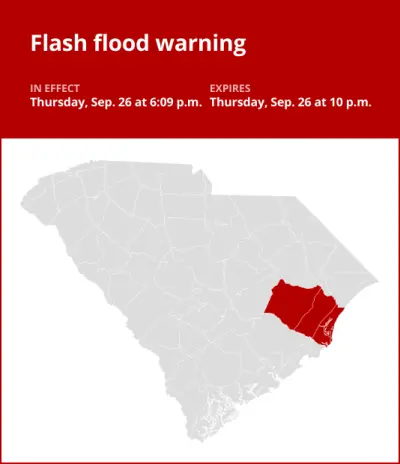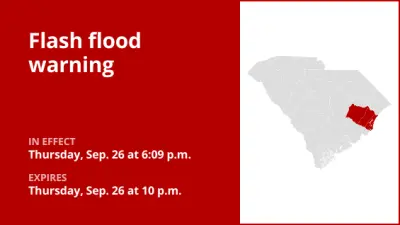On Thursday at 6:09 p.m. the National Weather Service issued a flash flood warning in effect until 10 p.m. for Georgetown and Williamsburg counties.
“At 6:09 p.m., Doppler radar indicated thunderstorms producing heavy rain across the warned area. Up to 3 inches of rain have fallen. Additional rainfall amounts of 2 to 4 inches are possible in the warned area. Flash flooding is ongoing or expected to begin shortly,” adds the weather service. “Flash flooding of small creeks and streams, urban areas, highways, streets and underpasses as well as other poor drainage and low-lying areas.”
Locations impacted by the warning include Andrews, Warsaw, Morrisville, Earle, Rhems, Nesmith, Henry, Sampit, Lambert, Indiantown, North Santee and Stuckey.
The weather service comments, “Dangerous flooding from heavy rainfall can be expected, especially near poor drainage areas and other flood prone locations. It is harder to recognize flood dangers at night, as it will be difficult to determine the depth of the water. Roads may be damaged or washed away. Most flood deaths occur in vehicles. If flooding is observed, then turn around, don’t drown.”
This warning is in effect until 10 p.m.

Breaking down weather alerts: advisories, watches, and warnings
Flash flood warning: Take action!
A flash flood warning is issued when a flash flood is either imminent or already occurring. In flood-prone areas, it’s crucial to move immediately to higher ground. A flash flood is a sudden and violent inundation that can develop within minutes to hours, and it can even happen in areas not currently experiencing rainfall.
Flood warning: Take action!
A flood warning is issued when flooding is imminent or occurring.
Flood advisory: Be aware:
A flood advisory is released when flooding is not expected to reach a severity level necessitating a warning. Nonetheless, it can still cause considerable inconvenience and, without exercising caution, potentially lead to situations that threaten life and/or property.
Flood watch: Be prepared:
A flood watch is issued when conditions are favorable for flooding. It doesn’t guarantee that flooding will occur, but it signifies that the possibility exists.
Keeping safe during floods: Expert advice from the weather service
In flood-prone regions or while camping in low-lying areas, understanding and following the weather service flood safety guidelines can be a lifesaver:
Seek higher ground:If you reside in a flood-prone region or are camping in low-lying terrain, the first step to safety is relocating to higher ground.
Adhere to evacuation orders:If local authorities issue an evacuation order, heed it promptly. Prior to leaving, secure your home by locking it.
Disconnect utilities and appliances:If time allows, disconnect your utilities and appliances. This reduces the risk of electrical hazards during flooding.
Steer clear of flooded basements and submerged areas:Steer clear of basements or rooms where water has submerged electrical outlets or cords. This helps prevent electrical accidents.
Swift evacuation for your safety:If you notice sparks or hear buzzing, crackling, snapping, or popping noises, evacuate immediately. Avoid any water that may be charged with electricity.
Stay away from floodwaters:Never attempt to walk through floodwaters, even if they appear shallow. Just 6 inches of fast-moving water can forcefully sweep you off your feet.
Seek higher ground when trapped:Should you become trapped by moving water, reach the highest point possible and dial 911 to contact emergency services.
During periods of heavy rainfall, especially in low-lying and flood-prone areas, the risk of flooding escalates. Remember this crucial advice: never attempt to drive through water on the road, even if it appears shallow. According to the weather service, as little as 12 inches of rapidly flowing water can carry away most vehicles. Prioritize your safety by staying informed and prepared.
Navigating rainy roads: Safety tips for wet weather
When heavy rain sets in, the risk of flooding and hazardous driving conditions rises. Whether it’s prolonged rainfall or rapid runoff, being prepared is essential. Here are some valuable safety tips from the weather service to ensure you stay safe in heavy rain:
Beware of swollen waterways:During heavy rain, avoid parking or walking near culverts or drainage ditches, where swift-moving water can pose a serious risk.
Maintain safe driving distances:Adhere to the two-second rule for maintaining a safe following distance behind the vehicle in front of you. In heavy rain, allow an additional two seconds of distance to compensate for reduced traction and braking effectiveness.
Slow down and drive with care:On wet roads, reducing your speed is crucial. Ease off the gas pedal gradually and avoid abrupt braking to prevent skidding.
Choose your lane wisely:Stick to the middle lanes to minimize the risk of hydroplaning. Outer lanes are more prone to accumulating water.
Prioritize visibility:Enhance your visibility in heavy rain by turning on your headlights. Watch out for vehicles in blind spots, as rain-smeared windows can obscure them.
Watch out for slippery roads:The first half-hour of rain is when roads are slickest due to a mix of rain, grime, and oil. Exercise heightened caution during this period.
Keep a safe distance from large vehicles:Don’t follow large trucks or buses too closely. The spray created by their large tires reduces your vision. Take care when passing them as well; if you must pass, do so quickly and safely.
Mind your windshield wipers:Overloaded wiper blades can hinder visibility. If rain severely impairs your vision, pull over and wait for conditions to improve. Seek refuge at rest areas or sheltered spots.
When stopping by the roadside is your only option, position your vehicle as far off the road as possible, ideally beyond guardrails. Keep your headlights on and activate emergency flashers to alert other drivers of your position.
By following these safety measures, you can significantly reduce risks and ensure your well-being when heavy rain pours down. Stay informed about weather conditions and heed advice from local authorities to make your journey safe and sound.






